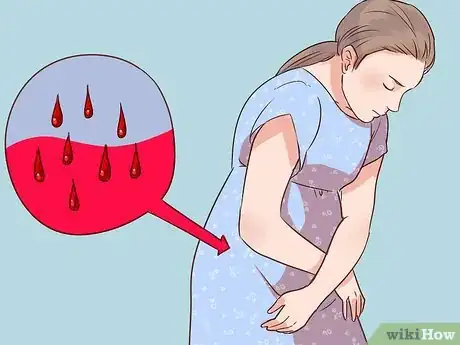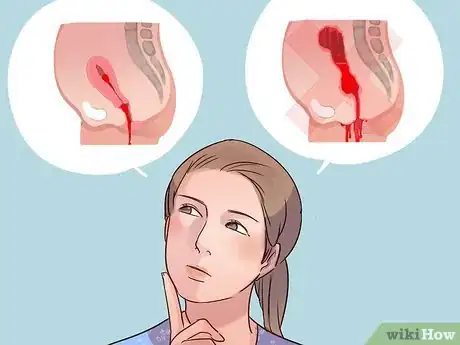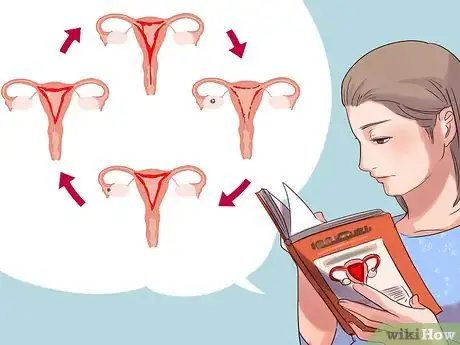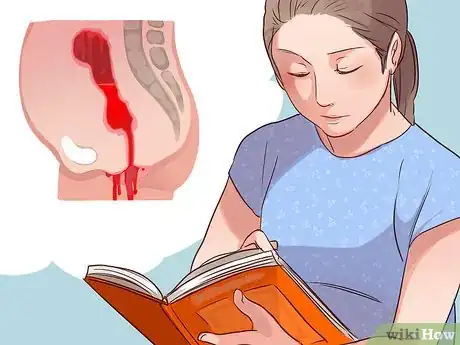This article was co-authored by Carrie Noriega, MD. Dr. Noriega is a Board Certified Obstetrician & Gynecologist and medical writer in Colorado. She specializes in women’s health, rheumatology, pulmonology, infectious disease, and gastroenterology. She received her MD from the Creighton School of Medicine in Omaha, Nebraska and completed her residency at the University of Missouri - Kansas City in 2005.
There are 13 references cited in this article, which can be found at the bottom of the page.
This article has been viewed 617,023 times.
Postpartum bleeding naturally occurs in all women after giving birth, and it can last for as long as six to eight weeks. Afterwards, the normal menstrual cycle should resume, but only if the mother is not breastfeeding or taking hormonal contraception. Sometimes it can be difficult to tell when postpartum bleeding has ended and normal menstruation has begun; however, there are several telltale signs you can watch out for.
Steps
Identifying the Differences
-
1Note the timing. The timing that periods resume with breastfeeding is often completely dependent on how long you breastfeed. If you only breastfeeds for three months your periods will likely return a few weeks after stopping, or if you breastfeed for 18 months, you may not have a period for this entire time. Postpartum bleeding, on the other hand, starts almost immediately after the childbirth and can last between six to eight weeks before tapering off.[1]
- Breastfeeding can delay menstruation as it triggers the body to release the prolactin hormones which keeps the progesterone and estrogen levels low.[2]
- Even if a woman decides not to breastfeed, she will not start menstruating for a couple of weeks after childbirth. Approximately 70% of women have their normal menstrual period roughly six to 12 weeks after giving birth. The period should only last for three to six days.[3]
-
2Examine the color. The color of the blood will be slightly different with postpartum bleeding than with menstruation, so it's important take note of this.[4]
- With postpartum bleeding, the color of the blood appears bright red for the first three days. Then from day four to 10, the discharge changes its color from pinkish red to reddish brownish with varying components such as old blood, white blood cells and tissue debris.[5]
- After day 10, a whitish discharge may be observed. This discharge consists of leukocytes (white blood cells), mucus, and epithelial cells.
- Although menstrual blood may also start as bright red, the color will change to dark red, black or brown towards the end of menstruation.[6]
Advertisement -
3Note the blood flow. The flow of blood is heavier in postpartum bleeding than in menstruation. In general, postpartum bleeding will be heavy for the first four days, then will gradually reduce in quantity over the next few days/weeks.
- If you are saturating a super-pad each hour for at least three hours, or having blood clots bigger than a golf ball after the first two to three days, call you doctor right away.
- With menstruation, blood flow is also heaviest in the first three to four days, however the average blood loss is only 10 ml to 80 ml.[7]
- An easy way to account for the amount of blood is to know that one tampon holds about 5 ml of blood. So, you can count the number of tampons you use and multiply that number by five to determine the total blood flow in milliliters.[8]
-
4Identify postpartum hemorrhage. You may experience something called postpartum hemorrhage, which occurs in about 1 in 100 to 5 in 100 women.[9] Postpartum hemorrhage is different from postpartum bleeding and requires immediate medical attention. Postpartum hemorrhage may be caused by pieces of the placenta remaining attached, tear in the cervix or other tissues, or a blood clotting disorder. If not treated, this can lead to shock, which can be fatal.[10] Signs of postpartum hemorrhage include:[11] [12]
- Vaginal bleeding that soaks more than one pad per hour over a period of two hours or a return of bright red bleeding with or without clots after vaginal discharge has become lighter or turned brown in color
- Decreased blood pressure
- Increased heart rate
- Decrease in the red blood cell count
Treating Postpartum Bleeding
-
1Adjust your diet. When you lose blood, you also lose iron. To avoid iron deficiency, increase the amount of iron you get through your daily diet. There are a number of foods that are naturally high in iron. They are:[13]
- Lentils and pinto or kidney beans
- Chicken, liver or beef
- Broccoli or asparagus
- Okra, parsley and kelp
- Mustard greens or beet greens
- Raisins, plums, dried peaches or prune juice
- Rice bran
- Blackstrap molasses
-
2Take iron supplements. For normal or mild postpartum bleeding, there is no need for any drugs to be taken as the bleeding will stop naturally after a maximum of six weeks to two months; however, your doctor may suggest or prescribe some iron supplements for you to treat any signs of anemia as a result of the blood loss.[14]
- Most over-the-counter supplements are fine, and are absorbed better with an acidic juice like pineapple or orange juice. Ask your doctor or pharmacist for recommendations if you are unsure about which brand to choose.
- These supplements are usually taken once a day, but it could be more frequent depending on the severity of your anemia. They should be taken after meals to avoid constipation, which can be a common side effect. Some other gastric disturbances may be felt, such as nausea or vomiting. You may also have green-colored stool.
-
3Receive medical treatment for postpartum hemorrhage. If you are experiencing postpartum hemorrhage, you need to seek immediate medical treatment to prevent shock. Treatments may include:
- A blood transfusion may be necessary to support vital organs such as the brain, heart, kidneys and liver and to prevent end organ damage. This blood transfusion will try to compensate for the excessive loss of blood.[15]
- Oxytocin will be administered through an IV to stimulate uterine contractions and control the bleeding.[16]
- Oxytocin acts mainly by stimulating strong uterine contractions by acting on specific receptors located at the lining of the smooth uterus muscles. It also increases the calcium levels in the intracellular space to induce more vasoconstriction.[17]
Understanding the Physiological Processes
-
1Know the causes of postpartum bleeding. If everything goes according to plan, the uterus will continue to contract after childbirth in order to expel any residue left over from the placenta. It is also the process of closing off all of the blood vessels that had been supporting the baby. The residue is what constitutes postpartum bleeding.
- This bleeding occurs while the uterus undergoes what's called the "stage of involution" — a normal physiologic response in which the uterus returns to its non-pregnant state. This bleeding is controlled and should not produce any adverse side effects.
- As time goes on, the outer layer of that lines the uterus slowly sloughs off and discharged. This discharge is called lochia.
- These processes are completely normal and expected. The uterus will normally heal on its own and the bleeding/lochia will stop within six weeks.
-
2Know the causes of menstrual bleeding. During a woman's normal menstrual cycle; the uterus is lined with a nutrient-rich coating to prepare for the arrival of a fertilized egg.[18]
- When fertilization does not occur, this lining shrinks and sloughs off before being expelled from the body, along with the unfertilized egg. Once the old lining is removed, a new lining forms and the cycle begins again.[19]
- Each menstrual period lasts for two to seven days, and occurs approximately every 28 days, though this varies from woman to woman.[20]
-
3Spot abnormal postpartum bleeding. In some instances, postpartum bleeding becomes excessive and poses serious health risks. You are bleeding too much if you soak through one or more sanitary pads per hour, have blood clots the size of a golf ball or larger, or continue to notice bright red blood after four days.[21] This may occur for a number of different reasons, like:[22]
- Uterine atony — This is the most common cause of excessive postpartum bleeding. It occurs when the uterus is unable to continue contracting — due to prolonged labor, infection, exhaustion, or the use of certain drugs (NSAIDs, nitrates) — allowing the blood to leak freely out of the body.[23]
- Placental retention or incomplete detachment — Put simply, this is when the placenta fails to completely detach from the uterus. The retained placenta results in postpartum bleeding.[24]
- Trauma to the uterus — Uterine trauma can happen due to several reasons, such as vigorous labor, attempting to remove the retained placenta (either manually, with special instruments, or with drugs that induce labor as Oxytocin). All of these things can cause injuries to the genital tract or uterus lining, causing excessive bleeding.[25]
- Other causes — Other potential causes of postpartum hemorrhage include an over-distended uterus (possibly from birthing twins), preeclampsia, infections or obesity.[26]
Expert Q&A
Did you know you can get expert answers for this article?
Unlock expert answers by supporting wikiHow
-
QuestionI gave birth 2 years ago but my periods are still very light. Do you have any idea what this could mean?
 Carrie Noriega, MDDr. Noriega is a Board Certified Obstetrician & Gynecologist and medical writer in Colorado. She specializes in women’s health, rheumatology, pulmonology, infectious disease, and gastroenterology. She received her MD from the Creighton School of Medicine in Omaha, Nebraska and completed her residency at the University of Missouri - Kansas City in 2005.
Carrie Noriega, MDDr. Noriega is a Board Certified Obstetrician & Gynecologist and medical writer in Colorado. She specializes in women’s health, rheumatology, pulmonology, infectious disease, and gastroenterology. She received her MD from the Creighton School of Medicine in Omaha, Nebraska and completed her residency at the University of Missouri - Kansas City in 2005.
Board Certified Obstetrician & Gynecologist
-
QuestionCan an erosion on my cervix cause bleeding?
 Carrie Noriega, MDDr. Noriega is a Board Certified Obstetrician & Gynecologist and medical writer in Colorado. She specializes in women’s health, rheumatology, pulmonology, infectious disease, and gastroenterology. She received her MD from the Creighton School of Medicine in Omaha, Nebraska and completed her residency at the University of Missouri - Kansas City in 2005.
Carrie Noriega, MDDr. Noriega is a Board Certified Obstetrician & Gynecologist and medical writer in Colorado. She specializes in women’s health, rheumatology, pulmonology, infectious disease, and gastroenterology. She received her MD from the Creighton School of Medicine in Omaha, Nebraska and completed her residency at the University of Missouri - Kansas City in 2005.
Board Certified Obstetrician & Gynecologist
References
- ↑ https://www.urmc.rochester.edu/Encyclopedia/Content.aspx?ContentTypeID=90&ContentID=P02486
- ↑ http://www.mayoclinic.org/healthy-lifestyle/womens-health/in-depth/menstrual-cycle/art-20047186?pg=2
- ↑ http://www.mayoclinic.org/healthy-lifestyle/womens-health/in-depth/menstrual-cycle/art-20047186?pg=2
- ↑ http://www.mayoclinic.org/healthy-lifestyle/labor-and-delivery/in-depth/postpartum-care/art-20047233
- ↑ http://www.mayoclinic.org/healthy-lifestyle/labor-and-delivery/in-depth/postpartum-care/art-20047233
- ↑ http://www.mayoclinic.org/healthy-lifestyle/womens-health/in-depth/menstrual-cycle/art-20047186
- ↑ http://www.mayoclinic.org/healthy-lifestyle/womens-health/in-depth/menstrual-cycle/art-20047186
- ↑ http://www.healthcentral.com/sexual-health/c/1443/145708/menorrhagia/
- ↑ http://www.healthcentral.com/sexual-health/c/1443/145708/menorrhagia/
- ↑ http://www.healthcentral.com/sexual-health/c/1443/145708/menorrhagia/
- ↑ http://www.healthcentral.com/sexual-health/c/1443/145708/menorrhagia/
- ↑ https://www.stanfordchildrens.org/en/topic/default?id=postpartum-hemorrhage-90-P02486
- ↑ http://www.ghc.org/healthAndWellness/?item=/common/healthAndWellness/pregnancy/newMom/care.html
- ↑ http://www.ghc.org/healthAndWellness/?item=/common/healthAndWellness/pregnancy/newMom/care.html
- ↑ http://www.mayoclinic.org/tests-procedures/blood-transfusion/basics/definition/prc-20021256
- ↑ http://www.mayoclinic.org/drugs-supplements/oxytocin-intravenous-route-intramuscular-route/description/drg-20065254
- ↑ http://www.mayoclinic.org/drugs-supplements/oxytocin-intravenous-route-intramuscular-route/description/drg-20065254
- ↑ http://www.mayoclinic.org/healthy-lifestyle/womens-health/in-depth/menstrual-cycle/art-20047186
- ↑ http://www.mayoclinic.org/healthy-lifestyle/womens-health/in-depth/menstrual-cycle/art-20047186
- ↑ http://www.mayoclinic.org/healthy-lifestyle/womens-health/in-depth/menstrual-cycle/art-20047186
- ↑ http://www.babycenter.com/0_postpartum-late-hemorrhage_1456138.bc
- ↑ http://www.babycenter.com/0_postpartum-late-hemorrhage_1456138.bc
- ↑ https://www.urmc.rochester.edu/Encyclopedia/Content.aspx?ContentTypeID=90&ContentID=P02486
- ↑ https://www.urmc.rochester.edu/Encyclopedia/Content.aspx?ContentTypeID=90&ContentID=P02486
- ↑ https://www.urmc.rochester.edu/Encyclopedia/Content.aspx?ContentTypeID=90&ContentID=P02486
- ↑ https://www.urmc.rochester.edu/Encyclopedia/Content.aspx?ContentTypeID=90&ContentID=P02486
About This Article
While postpartum bleeding and periods can look similar, you can tell the difference by noting of how soon the bleeding is happening after breastfeeding. For instance, if you breastfeed for 3 months, your periods will return a few weeks after stopping. While breastfeeding triggers the body to delay menstruation, even if you don’t breastfeed at all, you won’t start menstruating for a couple of weeks after childbirth. Another way to tell the difference is by looking at the color of your blood. During menstruation, bleeding will start as bright red and change to black or brown. If you notice a whitish discharge after 10 days of bleeding, you most likely have postpartum bleeding. For more help from our Medical co-author, like how to treat postpartum bleeding, scroll down.



































































Medical Disclaimer
The content of this article is not intended to be a substitute for professional medical advice, examination, diagnosis, or treatment. You should always contact your doctor or other qualified healthcare professional before starting, changing, or stopping any kind of health treatment.
Read More...